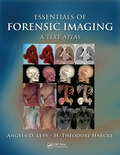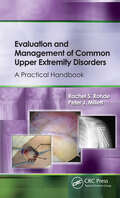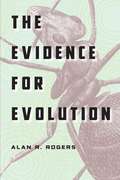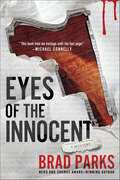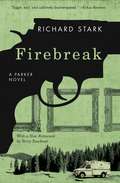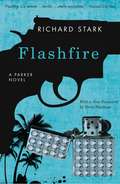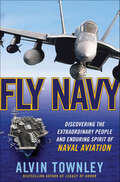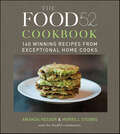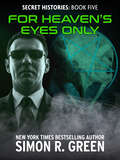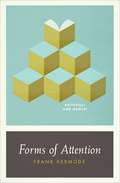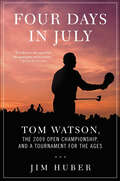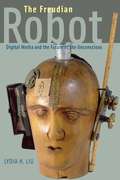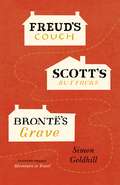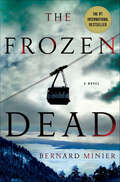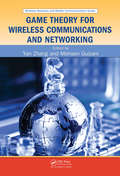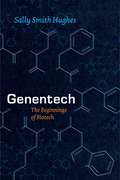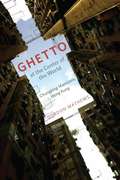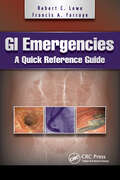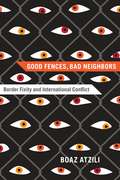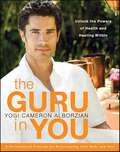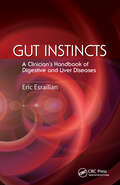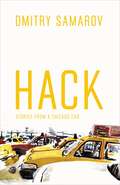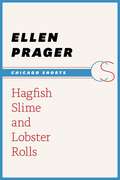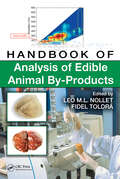- Table View
- List View
Essentials of Forensic Imaging: A Text-Atlas
by Angela D. Levy H. Theodore Harcke Jr.Bringing the long tradition of radiologic pathologic correlation to forensic radiology and autopsy, this volume provides readers with a technical and interpretive foundation for applying modern cross-sectional imaging to forensic autopsy. The book integrates more than 300 color images with basic forensic pathology in a topical format. The rich pictorial display of case material that accompanies the text establishes a contextual understanding of the material. Following an introduction to basic concepts and a review of imaging techniques, chapters are organized by cause of death. The atlas-like presentation is supported by full text explanations that review relevant forensic and radiologic principles.
Evaluation and Management of Common Upper Extremity Disorders: A Practical Handbook
by Peter Millett Rachel RohdeEvaluation and Management of Common Upper Extremity Disorders: A Practical Handbook answers the need for a comprehensive, yet concise reference that addresses practical solutions to everyday conditions that general orthopedic surgeons, and specialists alike, as well those involved with general musculoskeletal surgical and nonsurgical care, may encounter.User friendly and pocket size, Evaluation and Management of Common Upper Extremity Disorders by Drs. Rachel S. Rohde and Peter J. Millett provides information on how to diagnose, treat, and manage the most commonly encountered conditions of the upper extremity.Each condition addresses:• Mechanism of injury• Key examination points• Additional testing or imaging• Treatment options (operative and nonoperative)• Surgical anatomy• Surgical procedures• Rehabilitation• Expected outcomes• Potential complicationsJust a few of the conditions covered inside:• Trigger finger and de Quervain’s tenosynovitis• Distal radius fractures• Cubital tunnel syndrome• Distal biceps tendon rupture• Rotator cuff tears• Shoulder instabilityWritten in a bullet format, and including photos for quick, easy reference, Evaluation and Management of Common Upper Extremity Disorders: A Practical Handbook contains valuable information for all levels of training and experience. General orthopedic surgeons, orthopedic surgery residents and fellows, orthopedic surgery physician assistants, nurse practitioners, and nonoperative sports medicine specialists will welcome this thorough evaluation of common upper extremity disorders.
The Evidence for Evolution
by Alan R. RogersAccording to polling data, most Americans doubt that evolution is a real phenomenon. And it’s no wonder that so many are skeptical: many of today’s biology courses and textbooks dwell on the mechanisms of evolution—natural selection, genetic drift, and gene flow—but say little about the evidence that evolution happens at all. How do we know that species change? Has there really been enough time for evolution to operate?With The Evidence for Evolution, Alan R. Rogers provides an elegant, straightforward text that details the evidence for evolution. Rogers covers different levels of evolution, from within-species changes, which are much less challenging to see and believe, to much larger ones, say, from fish to amphibian, or from land mammal to whale. For each case, he supplies numerous lines of evidence to illustrate the changes, including fossils, DNA, and radioactive isotopes. His comprehensive treatment stresses recent advances in knowledge but also recounts the give and take between skeptical scientists who first asked “how can we be sure” and then marshaled scientific evidence to attain certainty. The Evidence for Evolution is a valuable addition to the literature on evolution and will be essential to introductory courses in the life sciences.
Eyes of the Innocent: A Mystery (The Carter Ross Mystery Series #2)
by Brad ParksCarter Ross, the sometimes-dashing investigative reporter for the Newark Eagle-Examiner, is back, and reporting on the latest tragedy to befall Newark, New Jersey, a fast-moving house fire that kills two boys.With the help of the paper's newest intern, a bubbly blonde known as "Sweet Thang," Carter finds the victims' mother, Akilah Harris, who spins a tale of woe about a mortgage rate reset that forced her to work two jobs and leave her young boys without child care. Carter turns in a front-page feature, but soon discovers Akilah isn't what she seems. And neither is the fire. When Newark councilman Windy Byers is reported missing, it launches Carter into the sordid world of urban house-flipping and Jersey-style political corruption. With his usual mix of humor, compassion, and street smarts, Carter is soon calling on some of his friends—gay Cuban sidekick Tommy Hernandez, T-shirt-selling buddy Tee Jamison, and on-and-off girlfriend Tina Thompson—for help in tracking down the shadowy figure behind it all.Brad Parks's debut, Faces of the Gone, won the Shamus Award and Nero Award for Best American Mystery. Now Parks solidifies his place as one of the brightest new talents in crime fiction with this authentic, entertaining thriller, Eyes of the Innocent.
Firebreak: A Parker Novel
by Richard StarkBetween Parker’s 1961 debut and his return in the late 1990s, the whole world of crime changed. Now fake IDs and credit cards had to be purchased from specialists; increasingly sophisticated policing made escape and evasion tougher; and, worst of all, money had gone digital—the days of cash-stuffed payroll trucks were long gone. But cash isn’t everything: Flashfire and Firebreak find Parker going after, respectively, a fortune in jewels and a collection of priceless paintings. In Flashfire, Parker’s in West Palm Beach, competing with a crew that has an unhealthy love of explosions. When things go sour, Parker finds himself shot and trapped—and forced to rely on a civilian to survive. Firebreak takes Parker to a palatial Montana "hunting lodge" where a dot-com millionaire hides a gallery of stolen old masters—which will fetch Parker a pretty penny if his team can just get it past the mansion’s tight security. The forests of Montana are an inhospitable place for a heister when well-laid plans fall apart, but no matter how untamed the wilderness, Parker’s guaranteed to be the most dangerous predator around.
Flashfire: A Parker Novel (The Parker Novels)
by Richard StarkBetween Parker’s 1961 debut and his return in the late 1990s, the whole world of crime changed. Now fake IDs and credit cards had to be purchased from specialists; increasingly sophisticated policing made escape and evasion tougher; and, worst of all, money had gone digital—the days of cash-stuffed payroll trucks were long gone. But cash isn’t everything: Flashfire and Firebreak find Parker going after, respectively, a fortune in jewels and a collection of priceless paintings. In Flashfire, Parker’s in West Palm Beach, competing with a crew that has an unhealthy love of explosions. When things go sour, Parker finds himself shot and trapped—and forced to rely on a civilian to survive. Firebreak takes Parker to a palatial Montana "hunting lodge" where a dot-com millionaire hides a gallery of stolen old masters—which will fetch Parker a pretty penny if his team can just get it past the mansion’s tight security. The forests of Montana are an inhospitable place for a heister when well-laid plans fall apart, but no matter how untamed the wilderness, Parker’s guaranteed to be the most dangerous predator around.
Fly Navy: Discovering the Extraordinary People and Enduring Spirit of Naval Aviation
by Alvin TownleyTop Gun was only part of the story. Fly Navy delves beyond the Hollywood image to reveal the true mettle and genuine story of the elite men and women of naval aviation.For one hundred years, the U.S. Navy's aviators and crews have made the difference on military and peacetime missions around the world. Their unparalleled skill, preparation, and everyday dedication have paid off when it matters most: when lives are on the line. Together, these men and women—officers and enlisted personnel, past and present—have protected freedom, served their country, and forged a legacy of valor like no other. In this landmark book, Alvin Townley takes readers on an adventure around the world and across generations as he goes behind the scenes of naval aviation. From the skies over the Arabian Sea to the jungles of Southeast Asia to carriers patrolling the vast Pacific, he uncovers incredible stories of service members who survived weeks adrift at sea, made midnight rescues in deadly storms, crash-landed behind enemy lines, and found themselves in situations where their exceptional training and focus were the only things standing between life and death. Filled with inspiring personal accounts of courage, camaraderie, and sheer perseverance, Fly Navy pays tribute to the extraordinary individuals who have built naval aviation into the revered force it is today—and will remain tomorrow.
The Food52 Cookbook: 140 Winning Recipes from Exceptional Home Cooks (Food52 Ser. #1)
by Amanda Hesser Merrill StubbsThe Best Cooks Are Home CooksAccomplished food writers and editors Amanda Hesser and Merrill Stubbs had a mission: to discover and celebrate the best home cooks in the country. Each week for fifty-two weeks, they ran recipe contests on their website, Food52.com, and the 140 winning recipes make up this book. They include:Double Chocolate Espresso CookiesSecret Ingredient Beef Stew Simple Summer Peach CakeWishbone Roast Chicken with Herb ButterThese recipes prove the truth that great home cooking doesn’t have to be complicated or precious to be memorable. This book captures the community spirit that has made Food52 a success. It features Amanda’s and Merrill’s thoughts and tips on every recipe, plus behind-the-scenes photos, reader comments, and portraits of the contributors—putting you right in the kitchen with America’s most talented cooks.
For Heaven's Eyes Only (Secret Histories #5)
by Simon R. GreenNew York Times bestselling author Simon R. Green’s Secret Histories fantasy adventure series featuring supernatural super-agent Eddie Drood continues.Eddie Drood here…well, not quite.Being a member of a secret-yet-legendary family of evil-battlers who have been shielding people from the darkest entities on Earth for ages can take its toll. So lately, I’ve been relaxing. Regrouping. Looking at things from a place of peace and quiet.After all, being dead does have its perks.Lucky for me my lovely witch Molly Metcalfe is able to pull me back to the mortal plane just in time for another disaster to befall the Drood clan and the world in general. It appears there is a Satanist conspiracy in the making. And I don’t mean your typical wear-black-eyeliner, mope-around-the-high-school, rebelling-against-daddy devil devotees. These Satanists are incredibly for real, extremely devoted to their dark lord, and dead serious about breaking down the gates of Hell to unleash…well, Hell.And the key to this is something called the “Great Sacrifice,” a horrific occurrence the likes of which humanity has never conceived—and will never survive. That is, unless an unlikely guardian angel leaps into the fray.Dammit…where did I put my wings and halo…?
Forms of Attention: Botticelli and Hamlet
by Frank KermodeSir Frank Kermode, the British scholar, instructor, and author, was an inspired critic. Forms of Attention is based on a series of three lectures he gave on canon formation, or how we choose what art to value. The essay on Botticelli traces the artist’s sudden popularity in the nineteenth century for reasons that have more to do with poetry than painting. In the second essay, Kermode reads Hamlet from a very modern angle, offering a useful (and playful) perspective for a contemporary audience. The final essay is a defense of literary criticism as a process and conversation that, while often conflating knowledge with opinion, keeps us reading great art and working with—and for—literature.
Four Days in July: Tom Watson, the 2009 Open Championship, and a Tournament for the Ages
by Jim HuberAward-winning golf reporter Jim Huber delivers the dramatic insider's account of golf legend Tom Watson's inspiring run at the British Open with Four Days in July.In July 2009, the sports world watched breathlessly as Watson, just shy of his sixtieth birthday and twenty-six years after his last Open title, battled Father Time through four amazing rounds at Turnberry. In Four Days in July, award-winning golf writer and commentator Jim Huber takes the reader from tee to fairway, from green to clubhouse, providing an intimate look at Watson's inspiring run.Entering the tournament as a sentimental wild card and nine years removed from his last top-ten finish in any of the four majors, "Old Tom" proceeded to shock the golf world by shooting an opening round 65. Although commentators and fans doubted he could keep up the level of play throughout the entire tournament, Watson proceeded not only to grab the lead but carry it into the final day.In Huber's hands, we can practically smell the wind blowing off the Irish Sea as we follow Watson and caddie Neil Oxman hole-by-hole along the Ailsa Course. A fascinating parallel narrative emerges as Stewart Cink, the fellow American more than twenty-three years Watson's junior who would be dubbed "The Man Who Shot Santa Claus," catches Watson in the fading sunlight that Sunday in Scotland and claims the British Open in a heart-wrenching four-hole playoff.The first media figure to speak with Watson at the end of each day, Huber mines his exclusive interviews with this golf legend as well as Oxman, Cink, and many other luminaries to recount a heroic tale of resilience, grit, and determination. This unforgettable story of the greatest links player ever and his courageous refusal to go gently into that good night is an unforgettable story that redeems the aging athlete in us all.
The Freudian Robot: Digital Media and the Future of the Unconscious
by Lydia H. LiuThe identity and role of writing has evolved in the age of digital media. But how did writing itself make digital media possible in the first place? Lydia H. Liu offers here the first rigorous study of the political history of digital writing and its fateful entanglement with the Freudian unconscious. Liu’s innovative analysis brings the work of theorists and writers back into conversation with one another to document significant meetings of minds and disciplines. She shows how the earlier avant-garde literary experiments with alphabetical writing and the word-association games of psychoanalysis contributed to the mathematical making of digital media. Such intellectual convergence, she argues, completed the transformation of alphabetical writing into the postphonetic, ideographic system of digital media, which not only altered the threshold of sense and nonsense in communication processes but also compelled a new understanding of human-machine interplay at the level of the unconscious. Ranging across information theory, cybernetics, modernism, literary theory, neurotic machines, and psychoanalysis, The Freudian Robot rewrites the history of digital media and the literary theory of the twentieth century.
Freud's Couch, Scott's Buttocks, Brontë's Grave: Adventures in Travel (Culture Trails)
by Simon GoldhillThe Victorian era was the high point of literary tourism. Writers such as Charles Dickens, George Eliot, and Sir Walter Scott became celebrities, and readers trekked far and wide for a glimpse of the places where their heroes wrote and thought, walked and talked. Even Shakespeare was roped in, as Victorian entrepreneurs transformed quiet Stratford-upon-Avon into a combination shrine and tourist trap. Stratford continues to lure the tourists today, as do many other sites of literary pilgrimage throughout Britain. And our modern age could have no better guide to such places than Simon Goldhill. In Freud's Couch, Scott’s Buttocks, Brontë's Grave, Goldhill makes a pilgrimage to Sir Walter Scott's baronial mansion, Wordsworth's cottage in the Lake District, the Bront ë parsonage, Shakespeare's birthplace, and Freud's office in Hampstead. Traveling, as much as possible, by methods available to Victorians—and gamely negotiating distractions ranging from broken bicycles to a flock of giggling Japanese schoolgirls—he tries to discern what our forebears were looking for at these sites, as well as what they have to say to the modern mind. What does it matter that Emily Brontë’s hidden passions burned in this specific room? What does it mean, especially now that his fame has faded, that Scott self-consciously built an extravagant castle suitable for Ivanhoe—and star-struck tourists visited it while he was still living there? Or that Freud's meticulous recreation of his Vienna office is now a meticulously preserved museum of itself? Or that Shakespeare’s birthplace features student actors declaiming snippets of his plays . . . in the garden of a house where he almost certainly never wrote a single line? Goldhill brings to these inquiries his trademark wry humor and a lifetime's engagement with literature. The result is a travel book like no other, a reminder that even today, the writing life still has the power to inspire.
From the Mouth of the Whale: A Novel
by SjónFrom the Mouth of the Whale is an Icelandic saga for the modern age. The year is 1635. Iceland is a world darkened by superstition, poverty, and cruelty. Men of science marvel over a unicorn's horn, poor folk worship the Virgin in secret, and both books and men are burned.Sjón introduces us to Jónas Pálmason, a poet and self-taught healer, banished to a barren island for heretical conduct, as he recalls his gift for curing "female maladies," his exorcism of a walking corpse on the remote Snjáfjöll coast, the frenzied massacre of innocent Basque whalers at the hands of local villagers, and the deaths of three of his children. Pálmason's story echoes across centuries and cultures, an epic tale that makes us see the world anew.
The Frozen Dead: A Novel (Commandant Martin Servaz #1)
by Bernard MinierNow available as a Netflix Original Series!Saint-Martin-de-Comminges is a small town nestled in the French Pyrenees. The kind of place where winters are harsh and unforgiving and where nothing ever happens.Until the winter morning when a group of workers discover the headless, flayed body of a horse, hanging suspended from the edge of a frozen cliff.On the same day the gruesome discovery takes place, Diane Berg, a young psychiatrist starts her first job at a high-security asylum for the criminally insane, just a few miles away. She is baffled by the slightly unorthodox methods the asylum's director uses, and then greatly alarmed when she realizes that drugs are disappearing from within the fortified institution while someone seems to be slipping out at night.Commandant Martin Servaz, a charismatic city cop from nearby Toulouse fond of quoting Latin, can't believe he has been called out over the death of an animal. But there's something disturbing about this crime that he can't ignore. Then DNA from one of the most notorious inmates of the asylum, a highly intelligent former prosecutor, accused of killing and raping several women, is found on the horse carcass . . . and a few days later the first human murder takes place. A dark story of madness and revenge seems to be unfolding. Servaz and his colleague, the mysterious Irene Ziegler, must use all their skill to solve the terrifying mystery and best one of the most fiendish and clever opponents they could ever imagine.
Game Theory for Wireless Communications and Networking (Wireless Networks And Mobile Communications Ser.)
by Yan Zhang Mohsen GuizaniThis comprehensive technical guide explains game theory basics, architectures, protocols, security, models, open research issues, and cutting-edge advances and applications. Describing how to employ game theory in infrastructure-based wireless networks and multihop networks to reduce power consumption, it facilitates quick and easy reference to related optimization and algorithm methodologies. The book explains how to apply the game theoretic model to address resource allocation, congestion control, attacks, routing, energy management, packet forwarding, and MAC.
Genentech: The Beginnings of Biotech (Synthesis Ser.)
by Sally Smith HughesIn the fall of 1980, Genentech, Inc., a little-known California genetic engineering company, became the overnight darling of Wall Street, raising over $38 million in its initial public stock offering. Lacking marketed products or substantial profit, the firm nonetheless saw its share price escalate from $35 to $89 in the first few minutes of trading, at that point the largest gain in stock market history. Coming at a time of economic recession and declining technological competitiveness in the United States, the event provoked banner headlines and ignited a period of speculative frenzy over biotechnology as a revolutionary means for creating new and better kinds of pharmaceuticals, untold profit, and a possible solution to national economic malaise. Drawing from an unparalleled collection of interviews with early biotech players, Sally Smith Hughes offers the first book-length history of this pioneering company, depicting Genentech’s improbable creation, precarious youth, and ascent to immense prosperity. Hughes provides intimate portraits of the people significant to Genentech’s science and business, including cofounders Herbert Boyer and Robert Swanson, and in doing so sheds new light on how personality affects the growth of science. By placing Genentech’s founders, followers, opponents, victims, and beneficiaries in context, Hughes also demonstrates how science interacts with commercial and legal interests and university research, and with government regulation, venture capital, and commercial profits. Integrating the scientific, the corporate, the contextual, and the personal, Genentech tells the story of biotechnology as it is not often told, as a risky and improbable entrepreneurial venture that had to overcome a number of powerful forces working against it.
Ghetto at the Center of the World: Chungking Mansions, Hong Kong
by Gordon MathewsThere is nowhere else in the world quite like Chungking Mansions, a dilapidated seventeen-story commercial and residential structure in the heart of Hong Kong’s tourist district. A remarkably motley group of people call the building home; Pakistani phone stall operators, Chinese guesthouse workers, Nepalese heroin addicts, Indonesian sex workers, and traders and asylum seekers from all over Asia and Africa live and work there—even backpacking tourists rent rooms. In short, it is possibly the most globalized spot on the planet. But as Ghetto at the Center of the World shows us, a trip to Chungking Mansions reveals a far less glamorous side of globalization. A world away from the gleaming headquarters of multinational corporations, Chungking Mansions is emblematic of the way globalization actually works for most of the world’s people. Gordon Mathews’s intimate portrayal of the building’s polyethnic residents lays bare their intricate connections to the international circulation of goods, money, and ideas. We come to understand the day-to-day realities of globalization through the stories of entrepreneurs from Africa carting cell phones in their luggage to sell back home and temporary workers from South Asia struggling to earn money to bring to their families. And we see that this so-called ghetto—which inspires fear in many of Hong Kong’s other residents, despite its low crime rate—is not a place of darkness and desperation but a beacon of hope. Gordon Mathews’s compendium of riveting stories enthralls and instructs in equal measure, making Ghetto at the Center of the World not just a fascinating tour of a singular place but also a peek into the future of life on our shrinking planet.
GI Emergencies: A Quick Reference Guide
by Robert Lowe Francis A. FarrayeGI Emergencies: A Quick Reference Guide contains practical information regarding the diagnosis and management of common gastrointestinal emergencies. Each chapter is written by a fellow or resident with an experienced clinician. This offers the perspective of a trainee, who has many basic questions about how to handle a given situation, combined with the experience of a seasoned practitioner who can guide the work-up and treatment of each clinical case. The result is a reference that provides the clinical acumen of a trained gastroenterologist in an easy-to-use format for physicians to approach GI emergencies efficiently and thoroughly. The dual-perspectives blend perfectly together to create a practical, evidence-based read for the learning physician.In GI Emergencies: A Quick Reference Guide, Dr. Robert C. Lowe and Dr. Francis A. Farraye, along with 20 contributors, help physicians deal with problems as they occur in a “real-time” format. Some Topics Include: • Evaluation and management of acute liver failure• Caustic ingestions, foreign bodies, and food impaction• Nonvariceal upper GI hemorrhage• Acute pancreatitis• Complications of endoscopyThe case-based format is less formal than that of a typical textbook, making it enjoyable without losing the educational value and evidence-based recommendations needed to provide excellent patient care. With succinct key teaching points, GI Emergencies: A Quick Reference Guide assists physicians who are training interns, residents, and medical students in training, making it an all-around reference for those in the gastroenterology field.
Good Fences, Bad Neighbors: Border Fixity and International Conflict
by Boaz AtziliBorder fixity—the proscription of foreign conquest and the annexation of homeland territory—has, since World War II, become a powerful norm in world politics. This development has been said to increase stability and peace in international relations. Yet, in a world in which it is unacceptable to challenge international borders by force, sociopolitically weak states remain a significant source of widespread conflict, war, and instability.In this book, Boaz Atzili argues that the process of state building has long been influenced by external territorial pressures and competition, with the absence of border fixity contributing to the evolution of strong states—and its presence to the survival of weak ones. What results from this norm, he argues, are conditions that make internal conflict and the spillover of interstate war more likely. Using a comparison of historical and contemporary case studies, Atzili sheds light on the relationship between state weakness and conflict. His argument that under some circumstances an international norm that was established to preserve the peace may actually create conditions that are ripe for war is sure to generate debate and shed light on the dynamics of continuing conflict in the twenty-first century.
The Guru in You: A Personalized Program for Rejuvenating Your Body and Soul
by Yogi Cameron Alborzian“If you really want to make a change in your life, gain health in body and mind, read Cameron's book. He’s improved my life and I hope you allow him to improve yours.” —NBC’s Maria Menounos, author of The EveryGirl’s Guide to Life“The Guru in You will gently guide you to a more conscious and meaningful life. [Cameron] will teach you how to lead a nourishing life by making wellness part of the superstar you truly are.” —Kris Carr, author of Crazy Sexy Cancer SurvivorInternational supermodel turned Ayervedic yogi, Cameron Alborzian, offers an inspirational guide to unlocking the secret power of health and healing that exists within all of us—a handbook for accessing The Guru in You.
Gut Instincts: A Clinician's Handbook of Digestive and Liver Diseases
by Eric EsrailianGut Instincts: A Clinician’s Handbook of Digestive and Liver Diseases is a practical handbook that focuses on the diagnosis and management of the most commonly encountered digestive diseases.Gut Instincts: A Clinician’s Handbook of Digestive and Liver Diseases is portable enough to keep in a lab coat or briefcase, yet informative enough for day-to-day patient care. Written and edited by Dr. Esrailian and over 50 contributing experts, the language throughout is clear and concise enough for application at the office, or at the bedside. Gut Instincts combines knowledge, experience, and evidence, helping providers of all levels to deliver the highest quality patient care. However, the chapters are concise and designed to be used as quick reference even during patient visits.Unique Benefits and Features Include: A “Gut Instincts” sidebar in each chapter with important clinical pearls for patient care Addresses the most frequently encountered clinical problems in digestive diseases Focuses primarily on diagnosis and management More than 50 algorithms, tables, and figures throughout the book Uses a coherent format while distributing high-yield information Some Chapter Topics Include: Barrett’s esophagus Pancreatic diseases Colon polyps Non alcoholic fatty liver disease Complications of portal hypertension Gut Instincts combines knowledge, experience, and evidence and is the ideal resource for practicing gastroenterologists and fellows, residents and medical students, nurse practitioners and physician assistants, and all primary care providers and trainees on the “front line” of patient care.
Hack: Stories from a Chicago Cab (Chicago Visions And Revisions Ser.)
by Dmitry SamarovCabdrivers and their yellow taxis are as much a part of the cityscape as the high-rise buildings and the subway. We hail them without thought after a wearying day at the office or an exuberant night on the town. And, undoubtedly, taxi drivers have stories to tell—of farcical local politics, of colorful passengers, of changing neighborhoods and clandestine shortcuts. No one knows a city’s streets—and thus its heart—better than its cabdrivers. And from behind the wheel of his taxi, Dmitry Samarov has seen more of Chicago than most Chicagoans will hope to experience in a lifetime. An artist and painter trained at the School of the Art Institute of Chicago, Samarov began driving a cab in 1993 to make ends meet, and he’s been working as a taxi driver ever since. In Hack: Stories from a Chicago Cab, he recounts tales that will delight, surprise, and sometimes shock the most seasoned urbanite. We follow Samarov through the rhythms of a typical week, as he waits hours at the garage to pick up a shift, ferries comically drunken passengers between bars, delivers prostitutes to their johns, and inadvertently observes drug deals. There are long waits with other cabbies at O’Hare, vivid portraits of street corners and their regular denizens, amorous Cubs fans celebrating after a game at Wrigley Field, and customers who are pleasantly surprised that Samarov is white—and tell him so. Throughout, Samarov’s own drawings—of his fares, of the taxi garage, and of a variety of Chicago street scenes—accompany his stories. In the grand tradition of Nelson Algren, Saul Bellow, Mike Royko, and Studs Terkel, Dmitry Samarov has rendered an entertaining, poignant, and unforgettable vision of Chicago and its people.
Hagfish Slime and Lobster Rolls (Chicago Shorts)
by Ellen PragerWhen viewed from a quiet beach, the ocean, with its rolling waves and vast expanse, can seem calm, even serene. But hidden beneath the sea’s waves are a staggering abundance and variety of active creatures, engaged in the never-ending struggles of life—to reproduce, to eat, and to avoid being eaten. With Hagfish Slime and Lobster Rolls, marine scientist Ellen Prager takes us deep into the sea to introduce an astonishing cast of fascinating and bizarre creatures that make the salty depths their home, with the help of stunning color photos. From the lobsters that battle rivals or seduce mates with their urine to hagfish that ties itself into a knot to keep from suffocating in its own slime—there’s far more to Prager’s account than her ever-entertaining anecdotes. Again and again, she illustrates the crucial connections between life in the ocean and humankind, enchanting us as she educates, enthralling us with the wealth of life in the sea, and reminding us of our need to protect it.
Handbook of Analysis of Edible Animal By-Products
by Leo M.L. Nollet Fidel ToldrÁWhile muscle foods are the more commonly consumed portion of an animal, animal by-products such as the entrails and internal organs are also widely consumed. This handbook, unique in the world, provides food scientists with a full overview of the tools available for the analysis of these by-products. Known for their superior handbooks on processed meats and poultry, muscle meat, dairy, and seafood, editors Nollet and Todra take the same comprehensive approach. They bring together leading experts who look at the techniques and methodologies for analyzing nutritional and sensory qualities as well as safety, includingthe detection of pathogens and toxins usually found in muscle foods.
